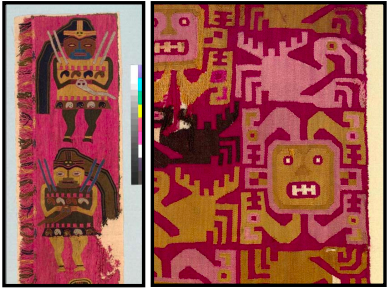Carmine, also named Imperial, is a red color that is slightly purple but closer to red than the color crimson. The color Carmine is known to be extracted by dried bodies of female insects, called Dactylopius coccus and Kermes, native to tropical and subtropical America. To prepare carmine, the powdered insect bodies are boiled in ammonia or sodium carbonate solution, the insoluble matter is removed by filtering, and alum is added to the clear salt solution of carminic acid to precipitate the red aluminum salt. Carmine was used in the Americas for dyeing textiles as early as 700 B.C. It was incorporated in fabrics that were only worn by royalty in South America starting in 1st century B.C.E. It is now commonly utilized in pastries, confections, cosmetics, water-soluble drug preparations, and histologic stains.
The left pattern was made by ancient Paracas people in the Inca region of Peru. The right pattern was made by Recuay Peruvians located in the Ancash region of Peru. The left image is an embroidered border fragment created during the 4th-3rd century B.C.E, while the right image was weaved during the 4th-6th century B.C.E. Although dominant, it seems that the carmine color serves a great purpose as a background in order to emphasize the imagery or designs. The carmine color is desaturated, therefore adding luminosity and brightness to the other colors that are used to make figures. The carmine appears to be a muted color, perhaps mixed with a small amount of black, to not distract from the importance of the figures.





Leave a Reply